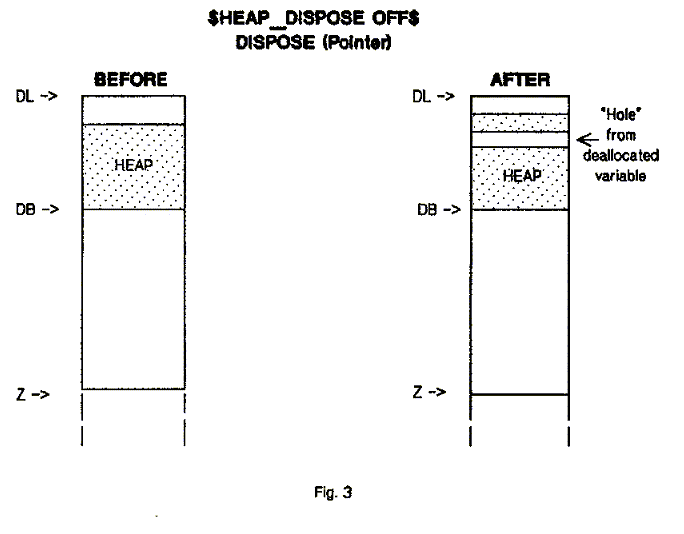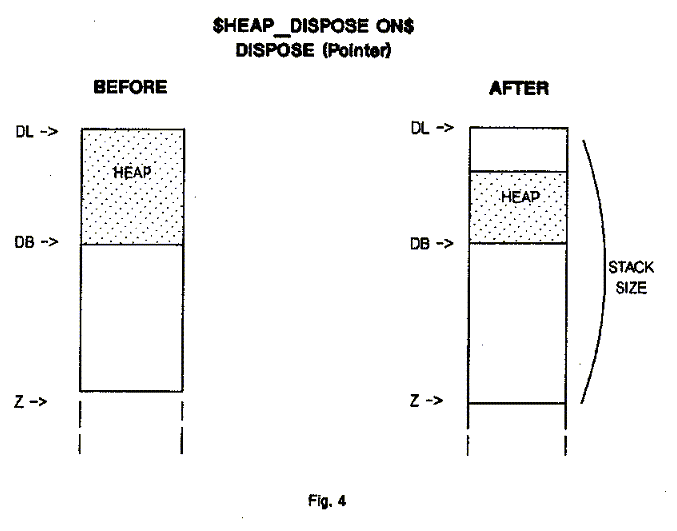|
|
|
HP Part Number: 5958-5824-2633
Published: August 15 1986
Notice
Is the Bit Baron in your HP3000 complaining about your Pascal
program's stack size? Does he say,
after you say...
If so, then it is probably time to examine some means of reducing the stack
memory required by your program.
One option, potentially very effective and available only to Pascal programmers,
is the use of Dynamic Variables. Dynamic Variables offer a means of dynamically
allocating, deallocating, and reallocating memory for GLOBALLY accessible data.
Dynamic Variables are allocated in the logical "Heap", and in comparison to
permanent global data, offer an enormous potential for stack memory savings.
However, in order to insure that a given implementation of Dynamic Variables
yields this savings, the PASCAL/3000 programmer needs to to take into account
some of the specifics of Heap memory management. If this is not done, poor
usage of Dynamic Variables can result in additional processing overhead with no
memory savings at all.
The Pascal/3000 compiler implements the Heap by allocating memory for Dynamic
Variables in the DL Area (DL to DB) of the user stack. The Heap begins with no
memory allocation. As Dynamic Variables are initially allocated, Heap growth
occurs away from DB and towards DL in descending memory locations.
 When Heap growth causes the Heap limit to descend to DL, the DL Area is expanded
to accommodate the larger Heap. However, the inverse is not always true.
Contraction of the Heap will not always result in contraction of the DL Area.
When the Heap is contracted and the DL Area is not, the memory released from the
Heap is still counted in the DL Area.
This is very significant since the entire DL Area, not just the Heap within it,
is included in the stack size that is counted against a given MAXDATA. In light
of the fact that "Heap Compaction" efforts (to use the Manual's terminology) do
not assure stack memory savings in and of themselves, the key to deriving memory
savings from Dynamic Variables becomes one of programming for minimum DL Area
size.
Pascal/3000 programmers can indirectly control the size of the DL Area through
the Heap procedures they use for acquisition and disposition of Dynamic
Variables. The two basic alternatives are the use of NEW & DISPOSE
calls; or the use of NEW calls in conjunction with MARK and
RELEASE calls. Additionally, the $HEAP_DISPOSE$ and
$HEAP_COMPACT$ compiler options can alter the affect these procedures
have on Heap memory.
The use of these procedures and compiler options will control two important
aspects of Heap memory management. First, they will determine whether Heap
memory previously returned through the return of variables is ever reused, and
second, they will determine if the DL Area is ever contracted after expansion
due to Heap growth. It is worth noting at this point that PASCAL/3000 never
performs true "garbage collection" on the Heap (dynamic concatenation of
allocated variables). Heap memory management is limited to the two operations
just mentioned.
When Heap growth causes the Heap limit to descend to DL, the DL Area is expanded
to accommodate the larger Heap. However, the inverse is not always true.
Contraction of the Heap will not always result in contraction of the DL Area.
When the Heap is contracted and the DL Area is not, the memory released from the
Heap is still counted in the DL Area.
This is very significant since the entire DL Area, not just the Heap within it,
is included in the stack size that is counted against a given MAXDATA. In light
of the fact that "Heap Compaction" efforts (to use the Manual's terminology) do
not assure stack memory savings in and of themselves, the key to deriving memory
savings from Dynamic Variables becomes one of programming for minimum DL Area
size.
Pascal/3000 programmers can indirectly control the size of the DL Area through
the Heap procedures they use for acquisition and disposition of Dynamic
Variables. The two basic alternatives are the use of NEW & DISPOSE
calls; or the use of NEW calls in conjunction with MARK and
RELEASE calls. Additionally, the $HEAP_DISPOSE$ and
$HEAP_COMPACT$ compiler options can alter the affect these procedures
have on Heap memory.
The use of these procedures and compiler options will control two important
aspects of Heap memory management. First, they will determine whether Heap
memory previously returned through the return of variables is ever reused, and
second, they will determine if the DL Area is ever contracted after expansion
due to Heap growth. It is worth noting at this point that PASCAL/3000 never
performs true "garbage collection" on the Heap (dynamic concatenation of
allocated variables). Heap memory management is limited to the two operations
just mentioned.
NEW
Calls to the NEW procedure will allocate enough memory for the variable defined
by the pointer type plus an additional two bytes used to record the variable's
length. With the exception of one case, the variable will be allocated at the
Heap limit (the end of the Heap closest to DL). This pushes the Heap limit
towards DL and often requires expansion of the DL Area.
When the $HEAP_DISPOSE_ON$ compiler option is in effect, the NEW procedure will
first search the Heap for an available "hole" left by the prior return of
another Dynamic Variable. If a hole of sufficient size is found, the new
variable will be allocated there instead of at the end of the Heap. This option
is normally desirable if Dynamic Variables are being returned to the Heap
through calls to the DISPOSE procedure.

DISPOSE
The DISPOSE procedure performs a logical return of the specified variable by
resetting the pointer to it. This leaves the above mentioned "hole" in the heap
of allocated variables.
 If the $HEAP_COMPACT$ compiler option is in effect, and the DISPOSEd variable is
at the Heap limit, then the Heap itself, but not DL, will eventually be
contracted. This lopping off of the variable from the Heap can reduce the time
necessary for "hole" searches by the NEW procedure, but does not free any memory
from the DL Area.
If the $HEAP_COMPACT$ compiler option is in effect, and the DISPOSEd variable is
at the Heap limit, then the Heap itself, but not DL, will eventually be
contracted. This lopping off of the variable from the Heap can reduce the time
necessary for "hole" searches by the NEW procedure, but does not free any memory
from the DL Area.

RELEASE
As an alternative to the DISPOSE procedure, variables may be logically returned
to the Heap through the use of MARK and RELEASE calls. When the RELEASE
procedure is used to dispose of variables, both the HEAP and the DL Area will be
contracted, or cut back, to the limit of the Heap at the time of the previous
corresponding MARK call. This occurs regardless of the compiler options in
effect. It is the ONLY Pascal procedure which will cause the DL Area to be
contracted, and as such, has the greatest potential for stack memory savings.
 As a result of its operation though, the RELEASE procedure is only appropriate
for returning the most recently acquired Dynamic Variable(s). Additionally,
there are three important warnings associated with the use of this procedure.
As a result of its operation though, the RELEASE procedure is only appropriate
for returning the most recently acquired Dynamic Variable(s). Additionally,
there are three important warnings associated with the use of this procedure.
First, any dynamic variables allocated between matching MARK and RELEASE calls
are no longer accessible. If referenced after the RELEASE call, these
variables can cause a program abort with PROGRAM ERROR #24: BOUNDS VIOLATION.
The second warning involves the use of GETHEAP calls. Seldom used directly by
user applications, GETHEAP is called by VPLUS/3000 whenever a VOPENFORMF is
done. Care must be taken to insure that GETHEAP (or VOPENFORMF) calls are not
bracketed by MARK/RELEASE calls unless corresponding RETURNHEAP (or
VCLOSEFORMF) calls are included. Failure to do so will result in a program
abort when the RELEASE call attempts to contract DL over an allocated Getheap
Area; (PASCERR 607) RELEASE PARAMETER ENCLOSES GETHEAP AREA.
And finally, the DLSIZE intrinsic should not be called if Dynamic Variables
are allocated. This intrinsic can contract DL over allocated variables which
presents the danger of program aborts with bounds violation.
There is also one important performance consideration associated with the use of
Pascal/3000 Dynamic Variables. Expansion or contraction of the DL Area requires
that the stack be swapped out to virtual memory and brought back in. This is a
very high overhead operation. Expansions of DL can be minimized if an estimate
of the eventual heap size can be calculated prior to program execution. This
size can then be included in the DL= parm of the: PREP or : RUN for the program.
Since contractions of the DL Area only result from RELEASE calls, RELEASE calls
should be used as sparingly as possible.
IN REVIEW
To help clarify this "heap" of information, lets examine a few typical cases
where effective use of Dynamic Variables can save stack memory.
Tables of information with capacities that need to vary between runs (i.e.
product codes, personnel numbers, etc.) lend themselves to the use of the NEW
procedure with the default compiler options. By allocating a variable for each
table entry only as it is needed, the programmer can assure that tables never
over allocate memory for the data present during any given run. The default
compiler options ($HEAP_DISPOSE_OFF; HEAP_COMPACT_OFF$) eliminate the overhead
associated with NEW searches for available "holes" in the Heap.
Data that need only be present during one phase of a process' execution (i.e.
program initialization) can be allocated and then returned in mass through the
use of the MARK and RELEASE procedures.
And last, but not least, is dynamic, random, data. A good example of this was
seen in a monitor program that ran continuously and tracked information on
active sessions. A very large record was needed for each session so long as it
was active, yet it was not possible to predict how many records would be needed
at any given time nor how long any given record would need to exist. This
application successfully utilized the NEW and DISPOSE procedures with
$HEAP_DISPOSE_ON ;HEAP_COMPACT-ON$ to solve a reoccurring problem with stack
overflows.
|





